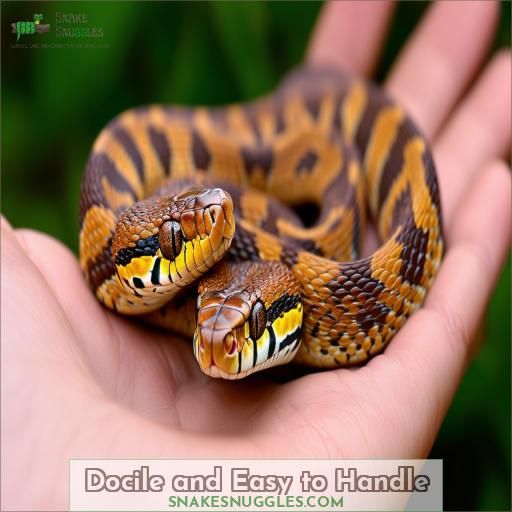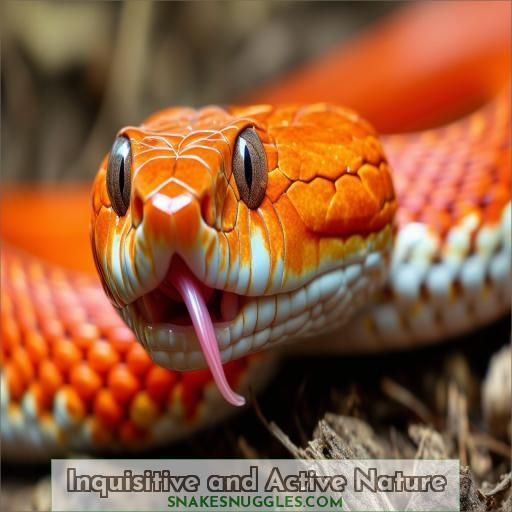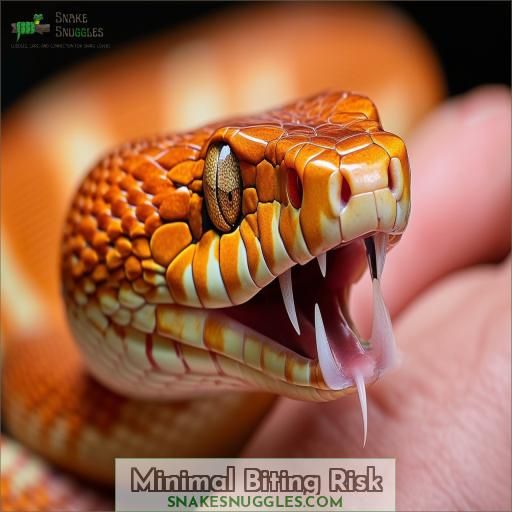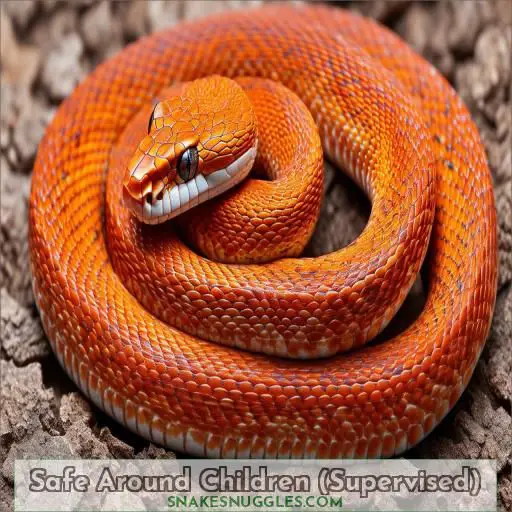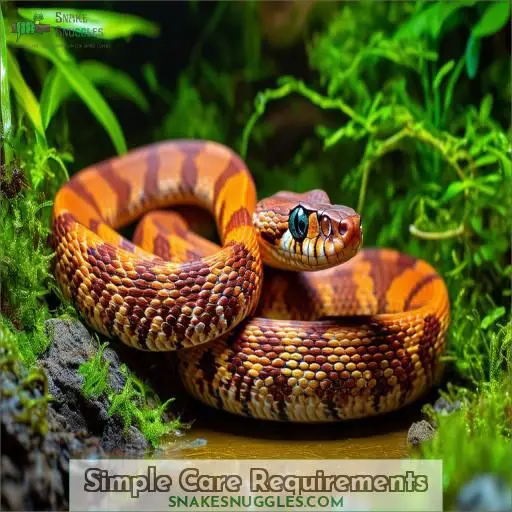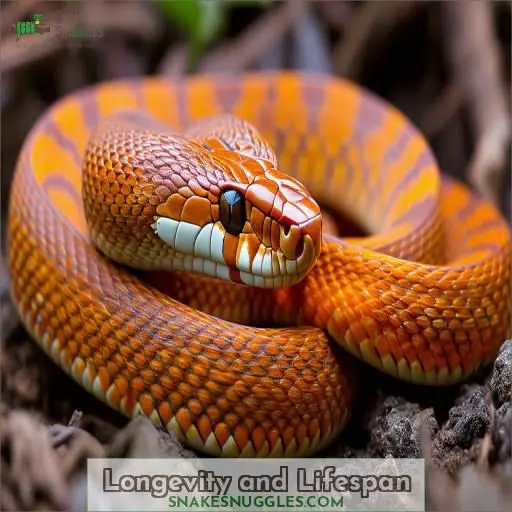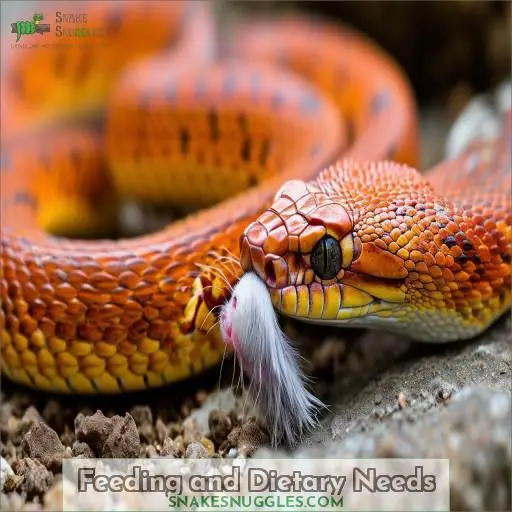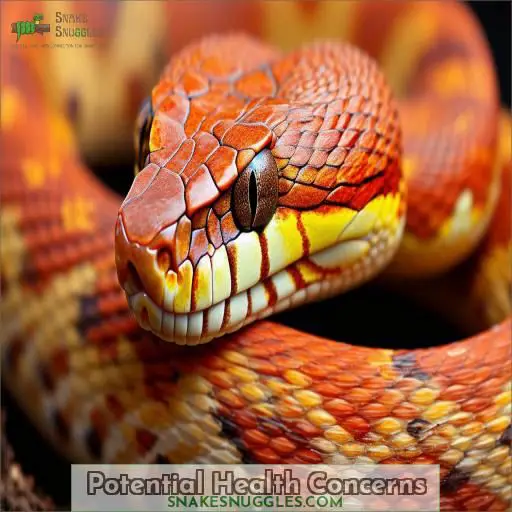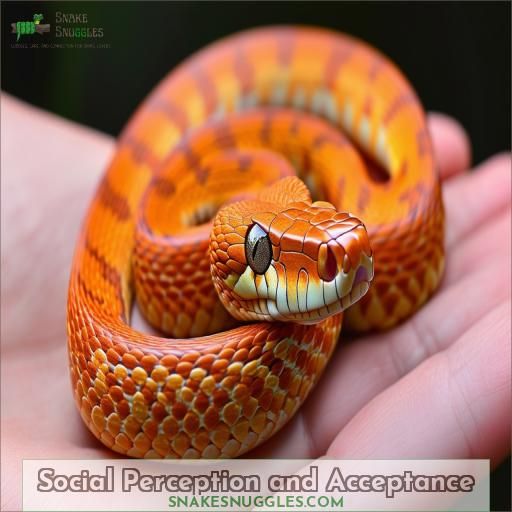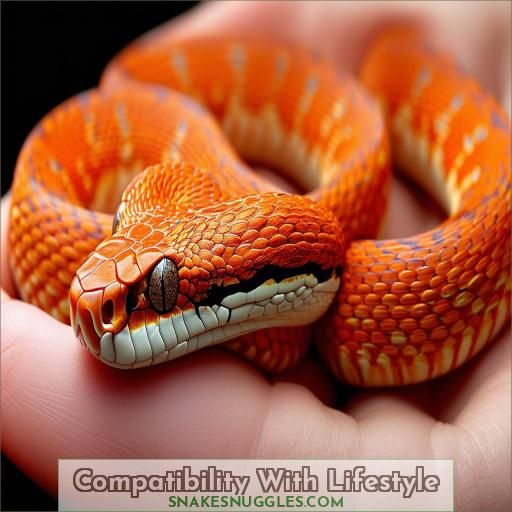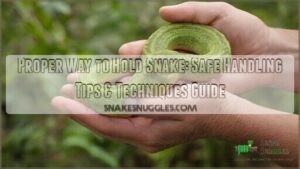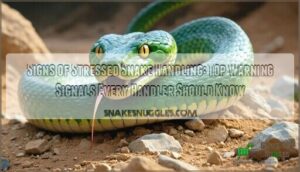This site is supported by our readers. We may earn a commission, at no cost to you, if you purchase through links.
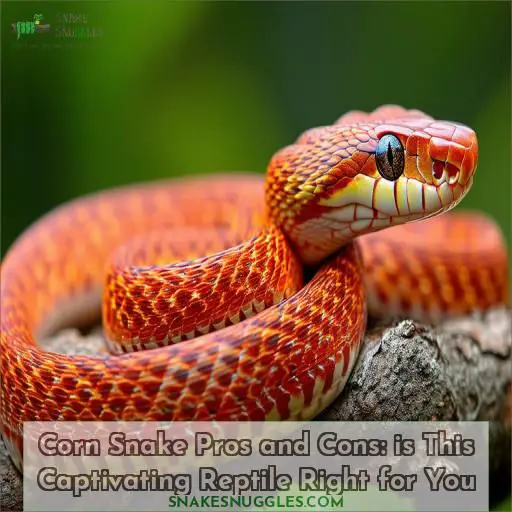 Considering a Corn Snake as a pet?
Considering a Corn Snake as a pet?
These alluring reptiles offer pros like a calm temperament, making them ideal for novice owners.
Their curious nature demands enrichment.
Potential cons include specialized feeding (frozen or live rodents every 7-14 days) and health concerns like respiratory issues or parasites.
While non-venomous with minimal biting risk, some may dislike snakes.
Weigh the manageable size, affordable costs, and 15-20 year lifespan against your lifestyle’s compatibility with their need for regular interaction.
Explore further to determine if this slithery companion suits you.
Table Of Contents
- Key Takeaways
- Docile and Easy to Handle
- Inquisitive and Active Nature
- Minimal Biting Risk
- Safe Around Children (Supervised)
- Simple Care Requirements
- Longevity and Lifespan
- Feeding and Dietary Needs
- Potential Health Concerns
- Social Perception and Acceptance
- Compatibility With Lifestyle
- Frequently Asked Questions (FAQs)
- What are the benefits of owning a corn snake?
- What is the biggest trouble with corn snakes as pets?
- Are corn snakes good or bad?
- What are the cons of snakes?
- How often do corn snakes need to be handled?
- Can corn snakes be housed together in one enclosure?
- What size prey items are appropriate for different ages?
- Are there any legal restrictions on owning corn snakes?
- Conclusion
Key Takeaways
- Corn snakes make great pets for beginners because they’re docile and easy to handle. They’re also relatively inexpensive to care for and don’t require a lot of space.
- Corn snakes are curious and active creatures that need plenty of enrichment in their enclosures. They love to climb and explore, so provide them with plenty of branches, hides, and other things to keep them entertained.
- Corn snakes are non-venomous and rarely bite, so they’re safe for families with children. However, it’s important to supervise children when they’re handling corn snakes, just to be safe.
- Corn snakes can live for 15-20 years, so they’re a long-term commitment. Before you get a corn snake, make sure you’re prepared to care for it for its entire life.
Docile and Easy to Handle
One of the biggest advantages of keeping a corn snake as a pet is their remarkably docile and easy-to-handle nature.
These fascinating reptiles are known for their calm temperament, making them a suitable choice even for novice reptile enthusiasts.
With proper handling techniques and equipment, you’ll find that corn snakes rarely become defensive or attempt to bite.
Their relaxed demeanor allows for stress-free interactions, whether you’re simply observing or gently handling them.
This docility is an invaluable trait, ensuring a positive pet ownership experience from the moment you welcome your new scaly companion home.
Inquisitive and Active Nature
Building on the docile and easy-to-handle nature of corn snakes, they’re also highly inquisitive and active creatures. You’ll find their:
- Exploratory behavior entertaining to observe
- Habitual curiosity requires environmental enrichment
- Activity levels benefit from appropriate space
- Captive enrichment prevents boredom and stress
- Frequent movements and shedding keeps them engaged
This animated species thrives on regular interaction and stimulation within their enclosure. Providing climbing branches, hides, and enrichment items allows them to exhibit natural behaviors like burrowing and perching. Their moderate size makes corn snakes ideal for handling, ensuring you can satisfy their inquisitive temperament safely.
Minimal Biting Risk
Raising a corn snake? You’ll be delighted to know they rarely bite.
Unlike venomous species, corn snakes are non-venomous and ideal for those with reptile allergies. Their gentle nature makes them suitable for beginners, requiring minimal behavioral training.
With proper handling techniques from a young age, corn snakes become accustomed to human interaction, further reducing bite risks.
As a responsible pet owner, understanding your snake’s needs is essential. Equipped with knowledge on corn snake care, bites become a non-issue, allowing you to focus on bonding with your fascinating new companion.
Safe Around Children (Supervised)
While corn snakes are generally docile, their interaction with children should be closely supervised. Follow these guidelines for safe handling:
- Teach proper [Handling techniques] like supporting the body.
- Implement [Safety precautions] by washing hands before and after.
- Adapt to the child’s [Age appropriateness], postponing unsupervised contact until responsible.
- Uphold [Parental responsibilities] by monitoring at all times.
With proper precautions, corn snakes can make rewarding family pets for children mature enough to appreciate them. Their calm demeanor allows kids to observe fascinating reptilian behaviors up close under your watchful eye. As an owner, you control the environment, setting your child up for an enriching experience.
Simple Care Requirements
One of the attractive features of corn snakes as pets is their manageable size, growing to a maximum length of around 4-6 feet. Additionally, the costs associated with acquiring and maintaining a corn snake are relatively affordable, making them an economical option for reptile enthusiasts.
Manageable Size
One key advantage is their manageable size:
| Age | Average Length |
|---|---|
| Baby | 12-18 inches |
| Juvenile | 24-36 inches |
| Adult | 3-5 feet |
An adult corn snake typically reaches 3-6 feet, easily housed in a 20-gallon tank or larger enclosure.
Affordable Cost
Corn snakes offer an affordable pet experience, with inexpensive initial investments for their enclosure and relatively low ongoing feeding costs compared to larger reptiles. Their modest size helps minimize long-term expenses, making them an attractive option for those on a budget.
Low Maintenance
Corn snakes are remarkably low-maintenance pets. With appropriate handling precautions, proper cage size, suitable bedding, ideal temperature gradients, and offering pre-killed feeder prey, their care needs are easily met. Their simplicity makes them ideal for busy reptile enthusiasts.
Longevity and Lifespan
One key consideration with corn snakes is their potential longevity, as they can live over 20 years in captivity, making them a long-term commitment. While this lifespan is a positive for dedicated owners, it also means rehoming a corn snake later in life can be challenging if your circumstances change.
Potential for Long-Term Commitment
When considering a corn snake, you’re committing to a pet that could live 15-20 years or more. Their reproductive habits and genetic diversity mean these snakes have impressive longevity. While that’s a pro for enjoying an enduring companion, the ethical considerations and potential emotional impact of such a long-term commitment can’t be overlooked.
Difficulty in Rehoming
With a lifespan exceeding 15 years, you’ll need to be ready for a long-term commitment. Rehoming can be tricky – these creatures form strong bonds. Make space for a lifelong scaly companion, ensuring you can provide the care it deserves over its longevity.
Feeding and Dietary Needs
One aspect of corn snake care to mull over is their dietary requirements. While rodents like mice or rats can be purchased from specialized pet stores, you’ll need to feed your corn snake an appropriately-sized prey item every 7-14 days, depending on the snake’s age and size.
Specialized Food Sources
Providing the proper diet is key for your corn snake’s health, especially when it comes to feeding the right prey. You’ll need to source frozen or live feeder rodents, which are available from online reptile stores or local pet suppliers. While frozen feeders are convenient, some owners prefer live prey feeding methods. Nutritional supplements may also be recommended by reptile experts.
Feeding Frequency
You’ll need to feed your corn snake frozen mice or live prey every 5-14 days, depending on its age. But be cautious of overfeeding, especially during shedding or breeding seasons when appetites may decrease. Consistency is key to maintaining a healthy weight and avoiding potential issues.
Potential Health Concerns
While corn snakes are generally hardy pets, you should be aware of potential health issues. These include shedding problems caused by improper humidity levels, respiratory infections from inadequate heating or ventilation, and internal parasites that may require veterinary treatment.
Shedding Issues
What’s more, you’ll need to watch out for shedding problems. Corn snakes shed regularly, but issues with timing, frequency, or incomplete shedding can signal health concerns. Proper humidity, substrates, and handling techniques help prevent shedding difficulties.
Respiratory Problems
You’ll want to watch out for respiratory infections, which can cause breathing difficulties. Poor habitat conditions may lead to lung infections like pneumonia in corn snakes. Proper humidity and ventilation are essential to avoid these breathing problems.
Parasites and Infections
You also need to watch out for parasites and infections. These include:
- Intestinal parasites from prey
- Bacterial skin infections
- Fungal respiratory infections
Proper husbandry and vet care can prevent most issues.
Social Perception and Acceptance
You should consider that many people harbor a fear or dislike of snakes, which could lead to negative reactions from guests or visitors in your home. While corn snakes are generally docile and unlikely to bite, their presence may still make some feel uncomfortable or uneasy.
Fear or Dislike of Snakes
While the potential health concerns are manageable, you must address the cultural stigma surrounding snakes. Many harbor personal biases against these reptiles due to media portrayal or lack of exposure. However, desensitization through responsible ownership can overcome such fears.
| Fear | Roots | Solution |
|---|---|---|
| Cultural stigma | Misconceptions | Education |
| Personal biases | Inexperience | Exposure therapy |
| Media portrayal | Sensationalism | Fact-checking |
Negative Reactions From Guests
Having a corn snake can be a social challenge, as many guests may react negatively due to the prevalent fear of snakes. This deeply-rooted public perception and social stigma around these enchanting reptiles could make some visitors uncomfortable or uneasy. Being mindful of this potential animal phobia is critical when considering a corn snake as a pet.
Compatibility With Lifestyle
While corn snakes are generally receptive to human interaction and can become accustomed to handling, their instinctive nature means they can’t be trained to perform tricks or respond to commands like some other domesticated pets. As reptiles, their behavior is primarily driven by basic needs and environmental cues rather than a desire to please their owners or learn complex behaviors.
Receptiveness to Human Interaction
While corn snakes may not be as receptive to humans as dogs or cats, you’ll find they:
- Respond to noises and movement with curiosity
- Explore their environment playfully if enriched
- Can display affection through tolerating handling
- Communicate through body language if understood
Bonding takes patience, but their inquisitive nature allows developing a unique reptilian connection.
Inability to Learn Tricks
You should also be aware that corn snakes lack the intelligence and trainability of more cognitively advanced pets. Unlike dogs or certain bird species, these reptiles can’t learn tricks or respond to commands, limiting opportunities for enrichment activities. If stimulating your pet’s mind through training is important, a corn snake may not provide the level of engagement you desire.
Frequently Asked Questions (FAQs)
What are the benefits of owning a corn snake?
As a popular choice among snake enthusiasts, corn snakes are one of the best snake species for beginners to consider when choosing the right snake, and their easy care, inquisitive nature, and manageable size make them a delightful companion. As one of the top beginner-friendly snake breeds, they are often recommended for new snake owners – docile charmers that rarely bite and are safe for families.
What is the biggest trouble with corn snakes as pets?
The biggest trouble with corn snakes is their long lifespan of 15-20 years, making them a substantial commitment that may become difficult to rehome if circumstances change.
Are corn snakes good or bad?
Let’s put it delicately: Corn snakes aren’t the easiest companions, but with proper knowledge, they can be quite rewarding pets. Mastering their care takes effort, but provides a sense of accomplishment and control over their well-being.
What are the cons of snakes?
Snakes require specialized care, have long lifespans making rehoming difficult, and can carry parasites. Some find them intimidating or are squeamish around them. Proper enclosures and heating are essential for their health.
How often do corn snakes need to be handled?
Handling corn snakes 1-2 times weekly maintains tameness. Too little contact breeds shyness; excessive handling stresses them. Find balance through patient, low-stress interactions.
Can corn snakes be housed together in one enclosure?
While corn snakes are generally solitary, you can house two together if the enclosure is large enough and you introduce them slowly. However, it’s best to keep corn snakes in separate enclosures to prevent potential issues.
What size prey items are appropriate for different ages?
Precisely picking proper prey portions promotes prime pet python prosperity. Pinkies please petite pythons; puny pups pander perfectly to plain-sized serpents, preventing potentially perilous predicaments.
Are there any legal restrictions on owning corn snakes?
In most places, you typically don’t need a permit to own corn snakes as pets. However, some cities and states have specific regulations or bans on owning certain reptiles, so it’s wise to check your local laws before getting one.
Conclusion
Envision the allure of a captivating corn snake slithering calmly in your hands.
Having weighed the pros and cons of owning this reptile, you’re now equipped to determine if its inquisitive nature and manageable care requirements align with your lifestyle.
Enter this potential commitment with realistic expectations regarding specialized feeding, potential health concerns, and social perceptions.
Only then can you confidently welcome this slithery companion into your world.

